
I have, in a series of columns, let my mind and keyboard wander across some of the destinations in which I’d experienced some situational sweetness.
“I am a sincere man
From where the palm trees grow
And before I die, I want to let my verses out of my soul…”
Anyone who visits Havana, Cuba swoons at the sound of the ever-present tune “Guantanamera,” a melody they recognize whether they hear the lyrics sung or not.
The Cuban ballad transcended the island and wafted into pop culture through films and television as the anthem of the island long before the American military and its’ naval base made people more aware of that remote location called Guantanamo – the area from which the man in the song hails.
It’s almost impossible to eat a meal or drink a mojito in Havana without the dining experience being accompanied by live musical acts. If you are hearing music in Havana, you will undoubtedly, in a short amount of time, hear “Guantanamera” if you didn’t already hear it in your head.
The song makes visitors settle back, breathe, draw on a cigar, and imagine they, themselves are a musician, fisherman, artist, or Ernest Hemingway himself.
And while they’re at ease in touch with their artistic side in a calmed state, do they see elegant, mysterious ladies in red dresses emerging from the shadows and sweeping over to attend to their needs…or is it their imaginations?
Relax for a moment, let go, and let’s find out.
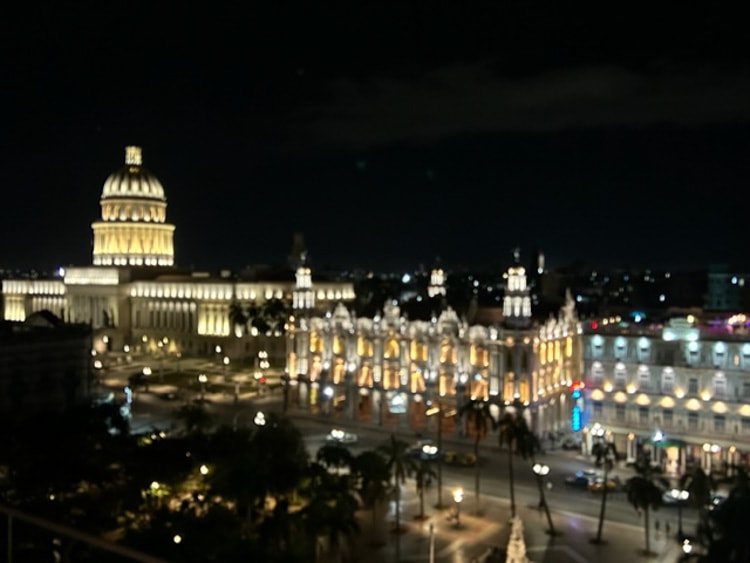
The Seduction of Solitude
Havana, Cuba entices and seduces the imaginations of people who visit. Also, those who will never set foot on the shore and walk the seven-mile Malecon walkway to see the sea smash and soar over the fishermen and all the way across the tops of the taxis motoring along the road.
Turning through the pages of the tales of Hemingway, the sensitive but macho outdoorsman and literary giant who, while living in Cuba, penned the prize-winning novella “Old Man the Sea,” one can feel the heartbeat and heartbreak of Cuba’s people and their culture.
To physically visit and explore the plazas and streets of Havana is to be physically transported to a city that, with its old-fashioned classic cars and simpler pace of life, may seem forgotten by time.
But Havana’s ornate, fanciful buildings and infrastructure have not been ignored by the erosion of the tropical elements and the challenges of a trade embargo against the governing political system.
A Cultural Haven Untouched by Commercialism
It is the lack of overly commercial encroachment, due to the blockade or otherwise, that maintains the timeless, cultural uniqueness of Havana.
Unlike, for instance, Dublin, Ireland, where visitors to once traditional Grafton Street can still see and hear the buskers perform, but they are amidst an M.A.C. makeup shop and Disney Store, for instance.
I’d like to think that even if the U.S. embargo ended, this portion of Havana would be spared the capitalistic invasion of Starbucks and McDonalds.
The dichotomy of the candy-colored classic Cadillacs and beautiful, but sometimes crumbling buildings is all part of Havana’s very visible story. But despair which, nevertheless, is not visible on the faces of the Cuban people, who, outside the tourist areas, endure gas shortages, supply chain issues, and power outages.
They project a warmth, even as they gaze over the Malecon into the turbulent ocean and swear they can spot the lights of the South Beach high-rises in Miami.

Seduction In the Center Of the City
The most remarkable “high rise” in Havana is the seemingly, especially at night, bejeweled capitol dome. Ironically, it is nearly identical to the United States Capitol building in Washington D.C. (but slightly, by purposeful design, taller.)
The best birds-eye view of the capital and Havana’s historic city center, including its central park, is from the sixth-floor, rooftop swimming pool deck of the Gran Hotel Manzana Kempinski La Habana. The luxury hotel, now Havana’s finest, is located inside the historic, early 20th-century Manzana de Gomez building.
After first serving as a school, this building expanded to become Cuba’s first shopping mall. Shopping for fashions, shoes, perfumes and art is still available to tourists in the hotel courtyard and breezeways.
Kempinski Saves the World
Kempinski Hotels deserves the praise and loyalty the company receives for its record of renovating and preserving historic buildings around the globe. They do this by turning them into vibrant, luxury hotels which become landmark destinations and social hubs.
A courthouse in Yangon, Myanmar; an 1858 Bavarian royal guesthouse in Munich; the neoclassical Central Telegraph Building in Vilnius, Lithuania; Singapore’s Capitol Building – a former theater; and an Ottoman imperial palace on the Bosphorus in Istanbul; plus current renovations in the Dresden, in Germany’s Saxony region, to name just a few.
Kempinski opened the Gran Hotel Manzana La Habana’s 246 rooms with 50 suites in 2017 and did a magnificent job of maintaining the buildings’ subtle, stately, authentic, Old Havana exterior appearance. In fact, a museum in the hotel basement displays photos of the original construction and building as well an entire wall of the original, rocky foundation.
Stepping inside, though, a new experience for Havana hotels presents itself. It begins with the lobby’s contemporary, modern, stylish luxury animated by doormen, a greeter, front desk staff, concierge and yes, the aforementioned, striking “ladies in red.” (More on them to come.)

The Sky is the Limit
Let’s continue at the top, via one of the hotel’s glass elevators. On the roof of Gran Hotel Manzana Kempinski, lunch, dinner and drinks can be enjoyed poolside, known as Bella Habana, as well as in the shaded open air of Bar Surtidor. Or indoors in the windowed, panoramic San Cristobal Restaurant and Bar.
Bites and meals such as slow-cooked lamb; steamed lobsters, suckling pig with pumpkin puree, and beef “Ropa Vieja, Cuban pork chops, pasta and other culinary treats are presented by servers in white linen dresses all day and night. According to the male bartender, it’s never too late, or too early, to request a drink. Diners can be as casual or as formal as they choose.
Lounging on cushioned chaises on the hotel’s roof can intoxicate guests via sweeping skyline views all the way to the Malecon and the sea; the intricate panorama of Havana Vieja’s ornate and sometimes crumbling buildings below; the very warm water of the swimming pool and heat of the sunshine; and, perhaps the mojitos and Cuba Libres. You are in the center of a UNESCO World Heritage site forbidden to some and fascinating to all.
In your ethereal, dazed condition of bliss, you can ramp up the Zen even more by stumbling to the hotel’s same-level Albear Spa – one of the 10-best in Latin America, to be further pampered. The surprisingly expansive fitness center and extensive spa seduce all the senses.
This includes the eyes because its treatment rooms, daybeds and peaceful relaxation areas are presented in an art-gallery-style setting with both darkened spots of solace and lots of natural light from even more sweeping views.
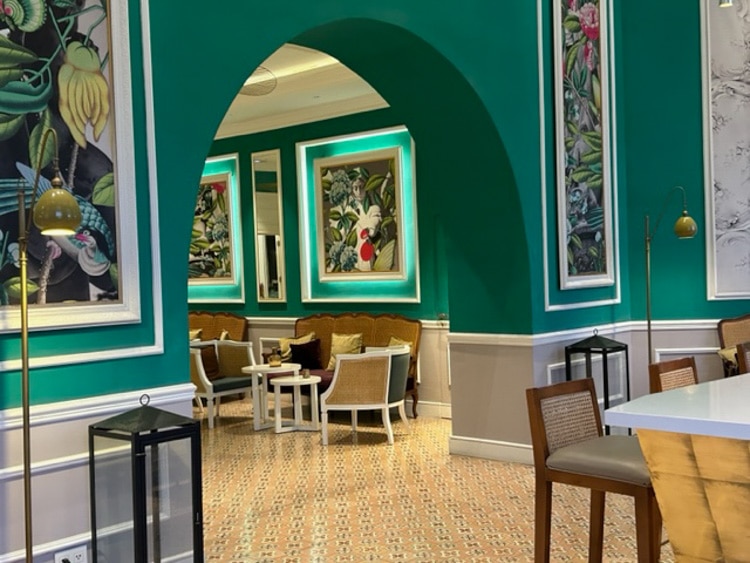
Rooms With a View
Between the Gran Hotel Manzana Kempinski’s rooftop paradise and the lobby are levels of guestrooms and a second floor of fun. All this surrounds an artsy lounge that can serve as an indoor reception area.
Gicela Diaz Viera, the hotel’s public relations manager, walked me through every hallway and corner of the hotel so I could view its varied charms and functions. She was well-versed in the history of the building and all its features.
“Many of our guests the Gran Hotel Manzana Kempinski’s guests come from Spain and Switzerland,” Gicela told me when I noticed various languages being spoken during our elevator ride.
Gicela was leading me toward the location of the daily breakfast buffet, which is included when I thought I saw two brunette ladies in red dresses sweep past the elevators through the lounge area.
But the doors to the breakfast restaurant closed behind me. So I continued with the tour and viewed the restaurant with its’ large, white-curtained windows behind which was a view of the park.
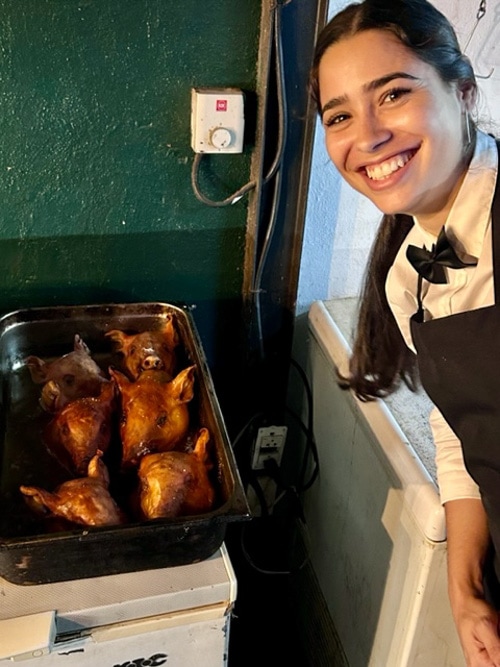
Cigars and Daiquiries
Next to the restaurant was an expansive, elegant cigar lounge called Evocacion, which housed a walk-in humidor overseen by the award-winning Juan Jesus Machin Gonzalez. He is known as a “master of masters” in pairing prized cigars with Cuban rum, and I was honored to meet briefly as he prepared for the day.
While the cigar lounge is sumptuous, dark and masculine, I found its counterpart, at the other end of the hall, to be the complete opposite in style: Bar Constante, with its turquoise-colored walls, arched passageways, tropical artwork, tiled floor and white marble bar is fanciful eye-candy.
As the sun streamed through its floor-to-ceiling balcony windows, Gicela explained why the lounge and bar had its name with a little game of show and tell. Beside the bar, outside the open window, and below on the corner of Calle Obispo and Monserrate streets, I spotted the famed dusty pink exterior and neon sign of the El Floridita bar. Gicela knew I would notice it.
“El Floridita’s bartender in 1914 was Constante Ribalaigua Vert. He went on to become the owner of the bar and invented the daiquiri,” Gicela explained.
Since the hotel’s bar had such an undeniably special view of “la cuna del daiquiri,” Gran Hotel Manzana decided to name its bar in honor of Constante.
Capturing My Imagination
I decided to linger, that late afternoon, in Constante. The place was mine, other than the bartender, who busied himself cleaning glasses until they sparkled. I opened the tall door to the tiny balcony overlooking the street and posted up at a high-top table with a stool.
A ceiling fan cooled Constante. In addition, a little breeze seemed to occasionally kiss the balcony as it wandered down the street through the twilight glow that cast dramatic shadows on Havana’s intricate buildings. The smoke of my cigar mixed with the breeze and I could not have been more contented or at ease.
I was not passing time…I was savoring my time smoking the cigar and sipping a fresh mojito.
I found myself enraptured in the moment. With no place to be, I was happy where I was. I enjoyed the languid ability to notice every detail and take an interest in it as if I were on a stakeout.
As colorful as the interior of Constante was, I let my eyes cast down onto the Calle Obispo corner where El Floridita was both visible and audible. The live music from the bar’s band was pleasantly muffled but clearer each time a customer went in and out of the door.
The Latin tunes accompanied by the shaking maracas were as colorful as the classic pastel-flavored Buicks, Thunderbirds, Chevrolets and yellow tuk-tuk taxis lined up out front. There was a horse and carriage driver ready for a rider on the plaza-like street in the space between the Gran Hotel Manzana and El Floridita.
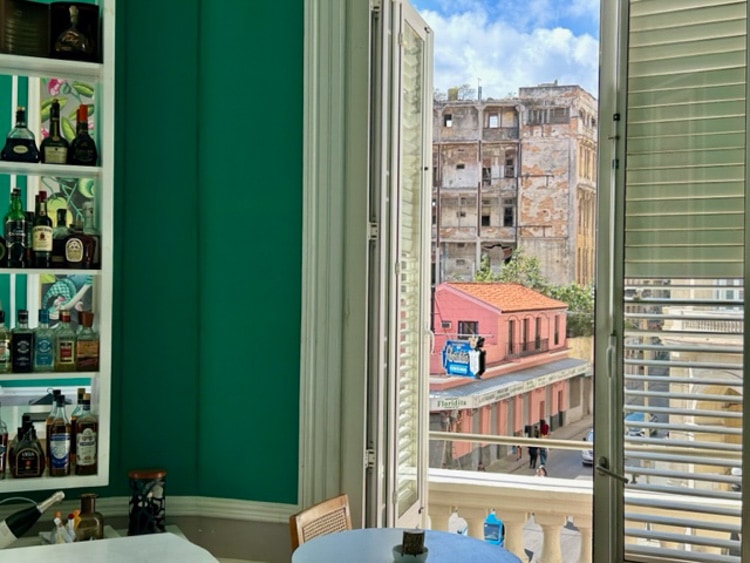
Inside El Floridita
Ernest Hemingway has been revered at El Floridita since the days he lived and wrote at his lovely Finca Vigia estate outside Havana and drank in town. Hemingway’s boat, the Pilar, which he piloted from the nearby fishing village of Cojimar, remains on display at on the grounds, which is now a museum.
El Floridita is just as important a pilgrimage sight for Hemingway aficionados. The waiters in red tuxedo jackets serve daiquiris named for him. There is a photo of the writer, known affectionately by Cubans as “Papa” and Fidel Castro on the wall. And I can only imagine what Hemingway would think of the life-sized statue of him standing at the end of the bar. (Hemingway often wrote, and drank, standing up.)
That statue is in the front corner of the bar, to the left, when you walk through the door. Papa would have seen all the goings’ on from that corner. In fact, everyone in the bar can view anyone who walks into what’s been dubbed “the greatest bar on earth” because the door is right next to the little, floor-level stage where a live band is always performing.
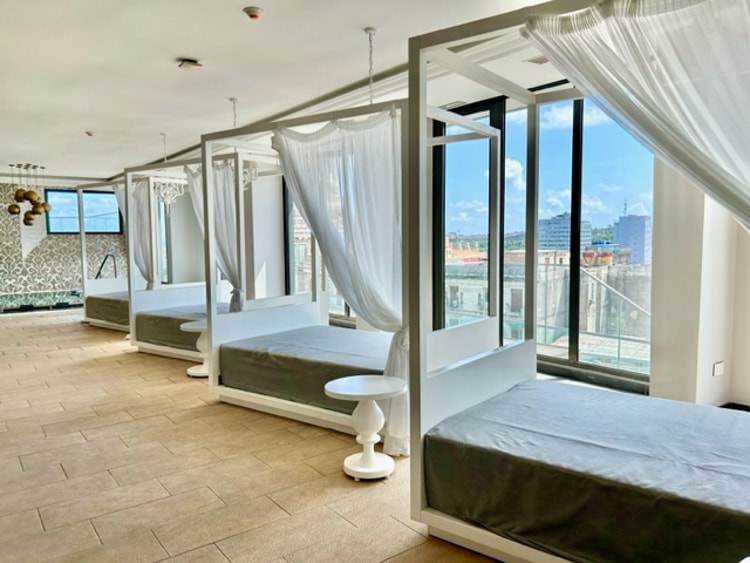
Day Dreaming
Having been in El Floridita and knowing all this about Hemingway, and now looking at the door of the establishment from the window above in Gran Hotel Manzana’s Constante bar, my mind wandered, in a relaxed fashion, to a tale I once heard of Papa’s close writing friend F. Scott Fitzgerald.
Fitzgerald frequented the Grove Park Inn Hotel in Asheville, North Carolina. Naturally the author of “The Great Gatsby” could have stayed in one of the hotel rooms with views overlooking the city below and the Great Smoky Mountains on the horizon.
Instead, Hemingway’s pal preferred a less-desirable room on the opposite, parking lot side of the hotel. His reason? So that all day long, while he sat by the window writing, he would have a bird’s eye view of the hotel’s entrance and scout the arrivals of any women coming into the Grove Park Inn.
As I sat in Constante’s window watching the streetscape and El Floridita’s door, I smiled and lifted my mojito to Fitzgerald. I also saluted the other notable writers who deigned to down a daiquiri at El Floridita, including Ezra Pound and Graham Greene, who penned the book “Our Man in Havana.”
As a writer myself, I indulged myself in the Havana hubris of accompanying them in the drink.
Dreams Come True
My mind was on writers as the sun was about to set to my right over Havana’s Capitol building and its neighboring, old, four-story Hotel Inglaterra, which had live music playing on its patio.
Milking my moment, my pop-culture imagination ran reels of 007 stories in which Ian Flemming cast his James Bond spy in Havana; and how Mario Puzo had Fredo Corleone struggle with ordering a banana daiquiri in “Godfather II.”
The previous night I’d walked Havana Viejo’s narrow streets around the Kempinski Hotel, which is in the middle of so many intriguing landmarks. Including the strikingly angular vertical architecture of the neighboring building that was formerly Bacardi Rum’s headquarters.
And just a block or two beyond that is the reason why the building is no longer Bacardi’s HQ: Cuba’s Museum of the Revolution in the former presidential palace.
Some museum exhibits – including Castro’s bullet-riddled jeep; the Granma yacht; a downed spy plane, a missile, and an Eternal Heroes of the Motherland Memorial Flame – are presented in the outdoor garden area and visible from the sidewalk.
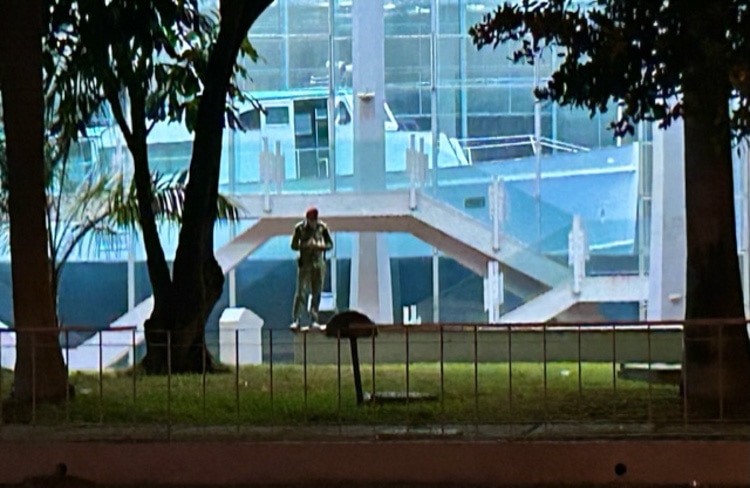
The Dancing Soldier
As I walked along the fence in the dark, I noticed a Cuban military guard, in his intimidating olive-green uniform and red beret, keeping his post by standing straight all tall on a small cement platform.
Because I was transfixed by his imposing visage, I watched him for a while in the shadows, without making eye contact. And because I was watching him for a while, I got to see something I considered revealing and special: Every few minutes this Cuban soldier, presumably to break up the monotony, would look around to see that no one was watching, and dance on the platform.
I am not connoisseur enough to know if it was salsa or soft shoe. But as incongruent as it was with the uniform and the military setting, it was delightful to see. So I stuck around to watch him do it a number of times – each time not believing my eyes. (I admit I was nervous about photographing a Cuban soldier, though.)
Seeing is Believing
Just a few doors from the Museum of the Revolution I entered a lively, two-story restaurant called El Carbon. Once again, the band was positioned in the front of the restaurant near the door, so patrons stepped immediately into the festive fun.
El Carbon was a colorful, well-decorated dining experience with a menu full of traditional, delicious dishes of all types at moderate prices. The upstairs section, reachable by a spiral staircase, was partly open-air and full of fauna.
It was there I spoke with a Cuban server who astonished me with her command of the Spanish and English languages. She could start a sentence in Spanish and finish it in English with no transition whatsoever. It was like a party trick!
She was as entertaining as the band was and said she was studying to be a psychologist. She’d hoped to work with children and gave me a fascinating explanation of how seeing what children draw, including the colors they use and the pressure with which they put crayons to paper, can tell a lot about their psyche.
Then she showed me one of the restaurants’ more unusual, exotic items when she pulled out a tray of broiled pigs heads. Like I’d seen 007 do in the movies, I tried not to flinch.
I took a taxi to what I was told is Havana’s hottest nightclub – Bar 2.45. It is owned in part by Javier Sotomayor, the greatest high jumper in Cuba’s history (thus, the name). He set two world records during Barcelona’s 1992 Olympic Games in Salamanca, Spain, which is the name of the attached restaurant.
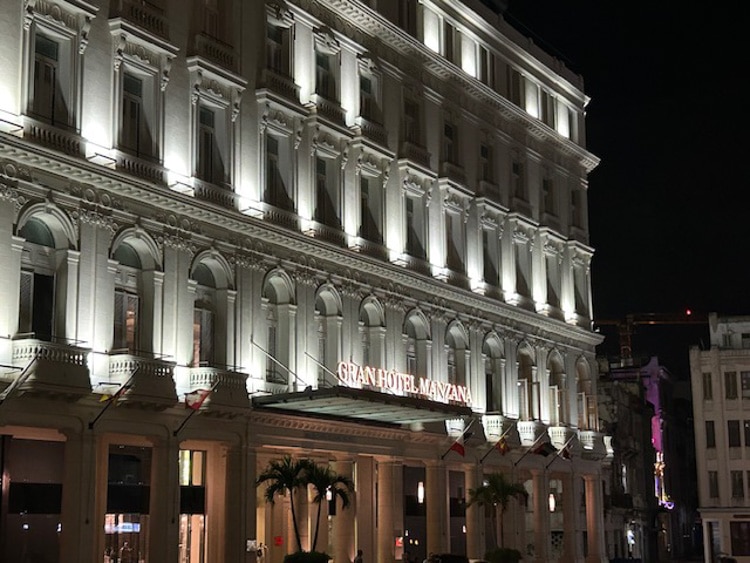
Resilience of Spirit
Inside the bumping club, with bottle service, dancing to DJ music, and then a late-night live superstar salsa performance, you would never believe the story the taxi driver told me on the short drive there. He’d come to Havana from Ukraine with his parents when he was a little boy.
“Russia and Cuba were close, then,” he explained.
But now he planned to emigrate to Canada, where he said the Canadian government provides immigrants with 15 free hotel nights and $3,000 Canadian dollars.
I asked him where in Canada.
“Anywhere,” he answered. “I don’t care where.”
The last straw for him was waiting 30 hours in line to buy gas for his taxi, which he said, compared to other countries, was an inexpensive $1.50 per gallon.
“You sat in your car in line for 30 hours?” I asked.
“Not exactly,” he explained. “Think of social media. Our social media was getting out of our cars and talking. Then getting back in to move the car. Sometimes we’d share a bite to eat while we waited.”
His car was not a classic antique, but rather a boxy little Soviet-made model.
Mind you, there was no talk of any transportation issues by the drivers who took me to and from central Havana from Jose Marti International Airport. Kempinski’s Gran Hotel Manzana can arrange that efficient transportation in advance.
One need only wander Havana to experience the dichotomy of disparity…coupled with the resilience of spirit and culture of the people.
Forbidden Fantasy
I sat still contemplating on Constante’s balcony, enjoying my Gran Hotel Manzana moment after all of this. Chilling at Constantine had given me the time to reflect on my days in Havana as if my life was a movie and I was on a set.
Then my ears were tickled. Was that, from El Floridita’s band below, the melody of Guantanamera I heard wafting up to the window scoring my scene? Of course, it was.
The forbidden fantasy of Havana had become real…but felt surreal.
But the next sound I heard over my shoulder was very real.
“Hello, sir. How are you?
Since I was the only one in the bar, I knew the voice had to be speaking to me, so I turned around to find two “Ladies in Red” right before my eyes. They stood, with perfect posture, in striking, perfectly pressed, knee-length, solid red dresses with impeccable hair and makeup.
They smiled with knowing expressions on their faces. The brunette, peaceful “Ladies in Red” had an ethereal quality about them.
It was the most gentle and greatest interruption ever.
All the Ladies in Red wanted was to know that I was happy, on behalf of the hotel.
I stood and introduced myself and explained who I was.
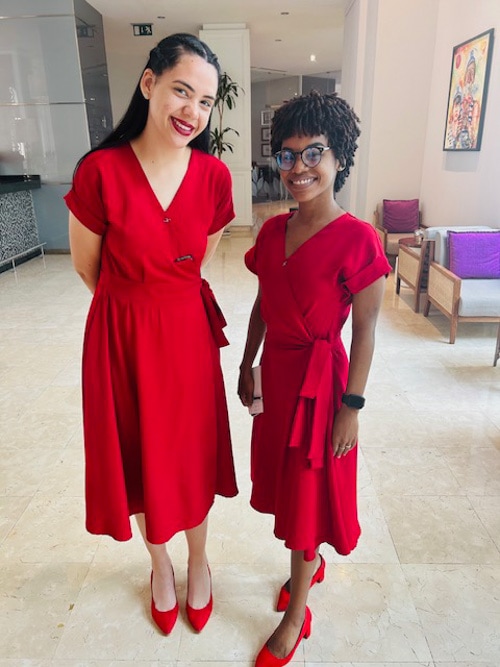
Kempinski’s The Ladies in Red
“We know who you are,” one of the ladies said, smiling. “We are the Ladies in Red.”
I came to learn the “all-knowing” Ladies in Red specialize in curating wisdom about the hotel’s guests and subtly make themselves available to intuitively ensure guests have a memorable and comfortable time.
“We are the ‘Ladies in Red,’ we are powerful,” Ariana said, with a gleam and the confidence Cuban woman culturally command. It was cute and charming.
As I did, guests will occasionally catch glimpses of the Ladies in Red throughout the hotel. They don’t lurk – it’s more like they float or sashay.
“You ladies are like celebrities,” I told them.
“Really?”
“Si,” I said. “Encountering you has a magical quality to it. It is like seeing Mickey Mouse at Disney World.” The ladies laughed, but it is true. They are ambassadorial.
Kempinski created the position at each of its illustrious properties to not only welcome guests but to share their unrivaled local knowledge and expertise about the hotel and local area. When the casual conversation moves into that realm, I noticed they become all business and take the dialogue seriously.
I observed them, with other guests at the pool and in the lobby, anticipating needs and requests, and even encouraging them to ask for them.
As for their “powers,” they can plan surprises, organize last-minute requests, and lead guests to experiences, even on-property, they might not have known about.
I salute the dreamy Ladies in Red at Kempinski Gran Hotel Manzana la Habana: Ariana, Ana, Iris, Amanda, Leslie, and Melanie.
Read more of Michael Patrick’s work at The Travel Tattler and contact him at [email protected]
- Chef Massimo Bottura’s Travel Trail – From Modena to Monaco and More - June 30, 2025
- Hilton’s Miami Airport Blue Lagoon Hotel – A Vibrant, Cultural Gateway to Havana - April 30, 2025
- Spend a Life at Sea Amidst Crystal Cruises Cuisine and Cache - April 19, 2025
